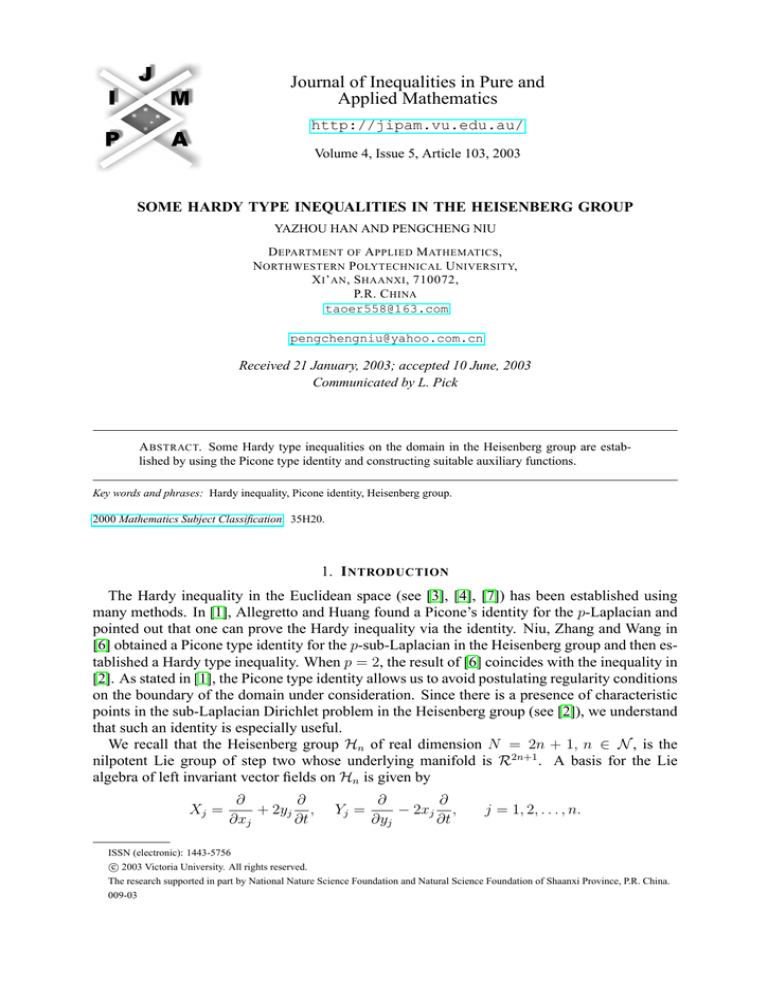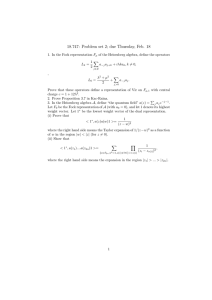
Journal of Inequalities in Pure and
Applied Mathematics
http://jipam.vu.edu.au/
Volume 4, Issue 5, Article 103, 2003
SOME HARDY TYPE INEQUALITIES IN THE HEISENBERG GROUP
YAZHOU HAN AND PENGCHENG NIU
D EPARTMENT OF A PPLIED M ATHEMATICS ,
N ORTHWESTERN P OLYTECHNICAL U NIVERSITY,
X I ’ AN , S HAANXI , 710072,
P.R. C HINA
taoer558@163.com
pengchengniu@yahoo.com.cn
Received 21 January, 2003; accepted 10 June, 2003
Communicated by L. Pick
A BSTRACT. Some Hardy type inequalities on the domain in the Heisenberg group are established by using the Picone type identity and constructing suitable auxiliary functions.
Key words and phrases: Hardy inequality, Picone identity, Heisenberg group.
2000 Mathematics Subject Classification. 35H20.
1. I NTRODUCTION
The Hardy inequality in the Euclidean space (see [3], [4], [7]) has been established using
many methods. In [1], Allegretto and Huang found a Picone’s identity for the p-Laplacian and
pointed out that one can prove the Hardy inequality via the identity. Niu, Zhang and Wang in
[6] obtained a Picone type identity for the p-sub-Laplacian in the Heisenberg group and then established a Hardy type inequality. When p = 2, the result of [6] coincides with the inequality in
[2]. As stated in [1], the Picone type identity allows us to avoid postulating regularity conditions
on the boundary of the domain under consideration. Since there is a presence of characteristic
points in the sub-Laplacian Dirichlet problem in the Heisenberg group (see [2]), we understand
that such an identity is especially useful.
We recall that the Heisenberg group Hn of real dimension N = 2n + 1, n ∈ N , is the
nilpotent Lie group of step two whose underlying manifold is R2n+1 . A basis for the Lie
algebra of left invariant vector fields on Hn is given by
Xj =
∂
∂
+ 2yj ,
∂xj
∂t
Yj =
∂
∂
− 2xj ,
∂yj
∂t
j = 1, 2, . . . , n.
ISSN (electronic): 1443-5756
c 2003 Victoria University. All rights reserved.
The research supported in part by National Nature Science Foundation and Natural Science Foundation of Shaanxi Province, P.R. China.
009-03
2
YAZHOU H AN AND P ENGCHENG N IU
The number Q = 2n + 2 is the homogeneous dimension of Hn . There exists a Heisenberg
distance
n
o1
2 4
0 0
0 2
0 2 2
0
0
0
d ((z, t), (z , t )) = (x − x ) + (y − y ) + [t − t − 2(x · y − x · y)]
between (z, t) and (z 0 , t0 ). We denote the Heisenberg gradient by
∇Hn = (X1 , . . . , Xn , Y1 , . . . , Yn ).
In this note we give some Hardy type inequalities on the domain in the Heisenberg group by
considering different auxiliary functions.
2. H ARDY I NEQUALITIES
First we state two lemmas given in [6] which will be needed in the sequel.
Lemma 2.1. Let Ω be a domain in Hn , v > 0, u ≥ 0 be differentiable in Ω. Then
(2.1)
L(u, v) = R(u, v) ≥ 0,
where
up−1
up
L(u, v) = |∇Hn u|p + (p − 1) p |∇Hn v|p − p p−2 ∇Hn · |∇Hn v|p−2 ∇Hn v,
v
vp u
R(u, v) = |∇Hn u|p − ∇Hn
· |∇Hn v|p−2 ∇Hn v.
p−1
v
Denote the p-sub-Laplacian by ∆Hn ,p v = ∇Hn · (|∇Hn v|p−2 ∇Hn v).
Lemma 2.2. Assume that the differentiable function v > 0 satisfies the condition −∆Hn ,p v ≥
λgv p−1 , for some λ > 0 and nonnegative function g. Then for every u ∈ C0∞ (Ω), u ≥ 0,
Z
Z
p
(2.2)
|∇Hn u| ≥ λ g|u|p .
Ω
Ω
Let BR = { (z, t) ∈ Hn | d ((z, t), (0, 0)) < R} be the Heisenberg group and δ(z, t) =
dist ((z, t), ∂BR ) , (z, t) ∈ BR , in the sense of distance functions on the Heisenberg group.
Theorem 2.3. Let Ω = BR \{(0, 0}, p > 1. Then for every u ∈ C0∞ (Ω),
p Z
Z
p−1
|z|p |u|p
p
(2.3)
|∇Hn u| ≥
,
p δp
p
Ω
Ω d
p
where |z| = x2 + y 2 , d = d ((z, t), (0, 0)) .
Proof. We first consider u ≥ 0. The following equations are evident:
Xj d = d−3 (|z|2 xj + yj t) , Yj d = d−3 (|z|2 yj − xj t) ,
2
Xj2 d = −3d−7 (|z|2 xj + yj t) + d−3 |z|2 + 2x2j + 2yj2 ,
(2.4)
2
2
Yj d = −3d−7 (|z|2 yj − xj t) + d−3 |z|2 + 2x2j + 2yj2 , j = 1, . . . , n
and
(2.5)
|∇Hn d| = |z|d−1 , ∆Hn d = (Q − 1)d−3 |z|2 .
Choose v(z, t) = δ(z, t)β = (R − d)β , in which β =
p−1
,
p
one has
Xj v = −βδ β−1 Xj d, Yj v = −βδ β−1 Yj d, j = 1, . . . , n,
∇Hn v = −βδ β−1 ∇Hn d, |∇Hn v| = |β|δ β−1 |z|d−1 ,
J. Inequal. Pure and Appl. Math., 4(5) Art. 103, 2003
http://jipam.vu.edu.au/
S OME H ARDY T YPE I NEQUALITIES IN THE H EISENBERG GROUP
3
and
−∆Hn v = −∇Hn · |∇Hn v|p−2 ∇Hn v
= −∇Hn · −β|β|p−2 δ (β−1)(p−1) |z|p−2 d2−p ∇Hn d
p−2
= β|β|
− (β − 1)(p − 1)δ (β−1)(p−1)−1 |z|p−2 d2−p |∇Hn d|2
+ δ (β−1)(p−1) d2−p ∇Hn |z|p−2 · ∇Hn d
+ (2 − p)δ (β−1)(p−1) |z|p−2 d1−p |∇Hn d|2
(β−1)(p−1)
p−2 2−p
+δ
|z| d 4Hn d .
From the fact ∇Hn (|z|p−2 ) · ∇Hn d = (p − 2)|z|p−4 d−3 |z|4 = (p − 2)|z|p d−3 and (2.5), it follows
that
p−2
−∆Hn v = β|β|
− (β − 1)(p − 1)δ (β−1)(p−1)−1 |z|p d−p
+ (p − 2)δ (β−1)(p−1) |z|p d−1−p
− (p − 2)δ (β−1)(p−1) |z|p d−1−p
+ (Q − 1)δ
(β−1)(p−1)
p −1−p
|z| d
δ |z|p v p−1
= β|β|
−(β − 1)(p − 1) + (Q − 1)
d dp δ p
p−1 p−1
p−1
δ |z|p v p−1
=
+ (Q − 1)
p
p
d dp δ p
p p p−1
p−1
|z| v
≥
.
p
dp δ p
p−2
The desired inequality (2.3) is obtained by Lemma 2.2. For general u, by letting u = u+ − u− ,
we directly obtain (2.3).
Theorem 2.4. Let Ω = Hn \{BHn ,R }, Q > p > 1. Then for every u ∈ C0∞ (Ω), there exists a
constant C > 0, such that
Z
Z
p
|∇Hn u| ≥ C
(2.6)
Ω
Proof. Suppose that u ≥ 0. Take v = log
Using (2.4) and (2.5) show that
Ω
d α
R
|z|p |u|p
.
dp d2p
, R < d = d ((z, t), (0, 0)) < +∞, α < 0.
α α−1
R
d
1
α
∇Hn v =
α
∇Hn d = ∇Hn d,
d
R
R
d
−2
|∇Hn v| = |α||z|d ,
J. Inequal. Pure and Appl. Math., 4(5) Art. 103, 2003
http://jipam.vu.edu.au/
4
YAZHOU H AN AND P ENGCHENG N IU
−4Hn v = −∇Hn · |∇Hn v|p−2 ∇Hn v
= −α|α|p−2 ∇Hn · |z|p−2 d−2(p−2)−1 ∇Hn d
p−2
= −α|α|
(p − 2)|z|p−3 d2(2−p)−1 ∇Hn (|z|) · ∇Hn d
+ (2(2 − p) − 1) |z|p−2 d2(1−p) |∇Hn d|2
p−2 2(2−p)−1
+ |z| d
4Hn d .
Since ∇Hn (|z|) · ∇Hn d = |z|3 d−3 , the last equation above becomes
p−2
−4Hn v = −α|α|
(p − 2)|z|p−3 d2(2−p)−1 |z|3 d−3
+ (3 − 2p)|z|p−2 d2(1−p) |z|2 d−2
p−2 3−2p
2 −3
+ (Q − 1)|z| d
|z| d
= −α|α|p−2 |z|p d−2p (p − 2 + 3 − 2p + Q − 1)
= −α|α|p−2 (Q − p)|z|p d−2p .
(2.7)
Noting
v p−1
= 0,
d→+∞ dp
lim
p−1
p−1
there exists a positive number M ≥ R, such that v dp < 1, for d > M . Since v dp is continuous
p−1
on the interval [R, M ], we find a constant C 0 > 0, such that v dp < C 0 . Pick out C 00 =
max{C 0 , 1} and one has v p−1 < C 00 dp in Ω. This leads to the following
−∆Hn v ≥ C
|z|p v p−1
,
d2p dp
p−2
where C = −α|α| C 00 (Q−p) , and to (2.6) by Lemma 2.2. A similar treatment for general u completes the proof.
In particular, α = p − Q (1 < p < Q) satisfies the assumption in the proof above.
Theorem 2.5. Let Ω be as defined in Theorem 2.4 and p ≥ Q. Then there exists a constant
C > 0, such that for every u ∈ C0∞ (Ω),
Z
Z
|u|p
|z|p
p
.
(2.8)
|∇Hn u| ≥ C
p
p log d
dp
Ω
Ω d
R
Proof. It is sufficient to show that (2.8) holds for u ≥ 0. Choose v = φα , φ = log Rd , where
R < d < +∞, 0 < α < 1. We know that from (2.4) and (2.5),
∇Hn φ = d−1 ∇Hn d, |∇Hn φ| = d−2 |z|,
∆Hn φ = d−1 4Hn d − d−2 |∇Hn d|2 = (Q − 2)|z|2 d−4 .
J. Inequal. Pure and Appl. Math., 4(5) Art. 103, 2003
http://jipam.vu.edu.au/
S OME H ARDY T YPE I NEQUALITIES IN THE H EISENBERG GROUP
5
This allows us to obtain
−∆Hn v = −∇Hn · |∇Hn v|p−2 ∇Hn v
= −∇Hn · |αφα−1 ∇Hn φ|p−2 αφα−1 ∇Hn φ
= −α|α|p−2 ∇Hn · φ(α−1)(p−1) |z|p−2 d2(2−p) ∇Hn φ
p−2
= −α|α|
(α − 1)(p − 1)φ(α−1)(p−1)−1 |z|p−2 d2(2−p) |∇Hn φ|2
+ (p − 2)φ(α−1)(p−1) |z|p−3 d2(2−p) ∇Hn (|z|) · ∇Hn φ
+ 2(2 − p)φ(α−1)(p−1) |z|p−2 d2(2−p)−1 ∇Hn d · ∇Hn φ
(α−1)(p−1)
p−2 2(2−p)
+φ
|z| d
4Hn φ
p−2
= −α|α|
(α − 1)(p − 1)φ(α−1)(p−1)−1 |z|p−2 d2(2−p) |z|2 d−4
+ (p − 2)φ(α−1)(p−1) |z|p−3 d2(2−p) |z|3 d−4
+ 2(2 − p)φ(α−1)(p−1) |z|p−2 d2(2−p)−1 |z|2 d−3
(α−1)(p−1)
p−2 2(2−p)
2 −4
+φ
|z| d
(Q − 2)|z| d
v p−1 |z|p
{(α − 1)(p − 1) + (p − 2)φ + 2(2 − p)φ + (Q − 2)φ}
φp d2p
v p−1 |z|p
= −α|α|p−2 p 2p {(α − 1)(p − 1) + (Q − p)φ} ,
φ d
Taking into account that 0 < α < 1 and p ≥ Q, we have
= −α|α|p−2
−α|α|p−2 (Q − p)φ ≥ 0,
and therefore
v p−1 |z|p
v p−1 |z|p
=
C
,
φp d2p
φp d2p
where C = −α|α|p−2 (α − 1)(p − 1). An application of Lemma 2.2 completes the proof of
Theorem 2.5.
−4Hn v ≥ −α|α|p−2 (α − 1)(p − 1)
R EFERENCES
[1] W. ALLEGRETTO AND Y.X. HUANG, A Picone’s identity for the p-Laplacian and applications,
Nonlinear Anal., 32 (1998), 819–830.
[2] N. GAFOFALO AND E. LANCONELLI, Frequency functions on the Heisenberg group, the uncertainty priciple and unique continuation, Ann. Inst. Fourier (Grenoble), 40 (1990), 313–356.
[3] G.H. HARDY, Note on a Theorem of Hilbert, Math. Zeit., 6 (1920), 314–317.
[4] G.H. HARDY, An inequality betweeen integrals, Messenger of Mathematics, 54 (1925), 150–156.
[5] D. JERISON, The Dirichlet problem for the Laplacian on the Heisenberg group, I, II, Journal of
Functional Analysis, 43 (1981), 97–141; 43 (1981), 224–257.
[6] P. NIU, H. ZHANG AND Y. WANG, Hardy type and Rellich type inequalities on the Heisenberg
group, Proc. A.M.S., 129 (2001), 3623–3630.
[7] A. WANNEBO, Hardy inequalities, Proc. A.M.S., 109 (1990), 85–95.
J. Inequal. Pure and Appl. Math., 4(5) Art. 103, 2003
http://jipam.vu.edu.au/






